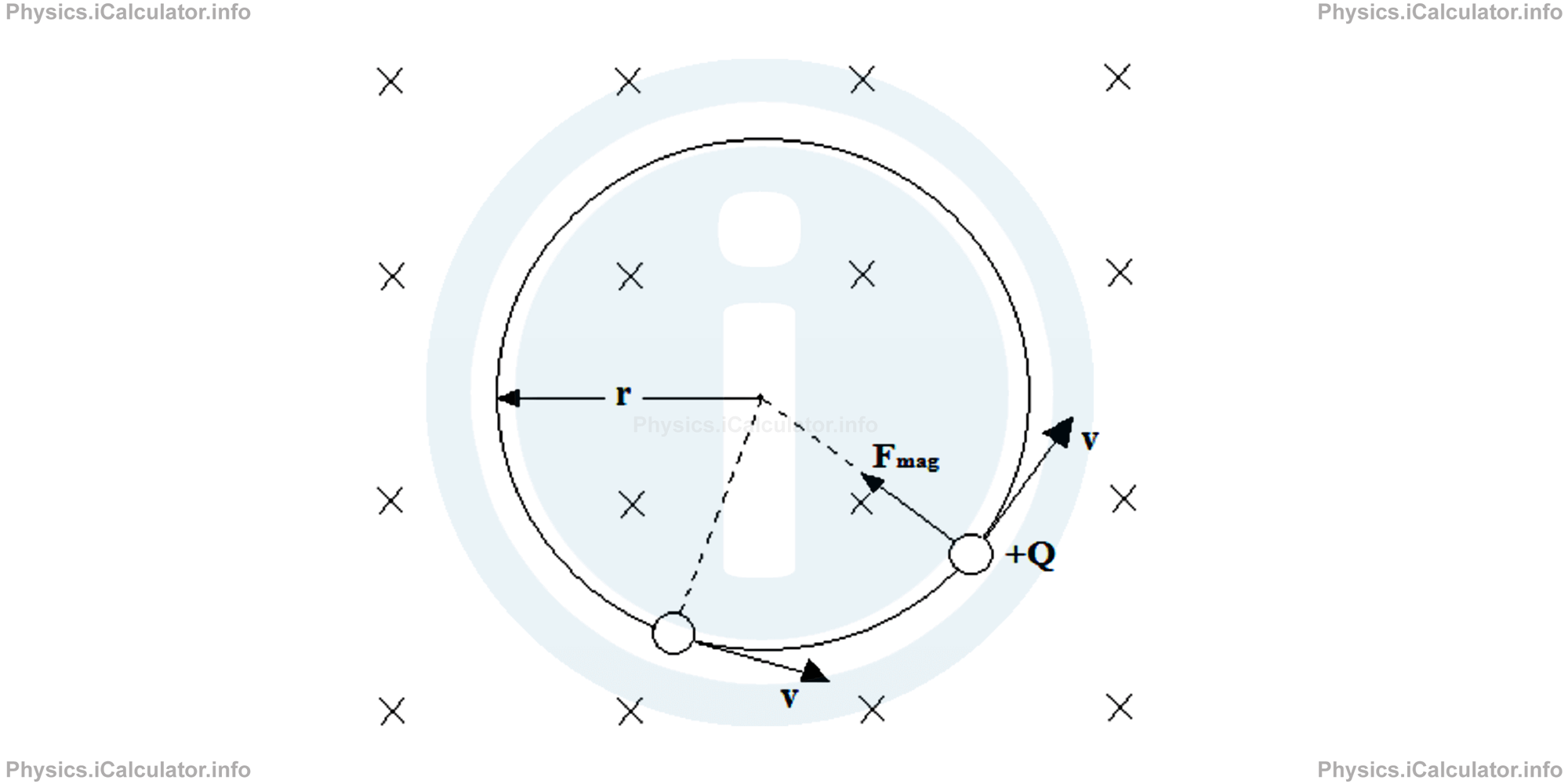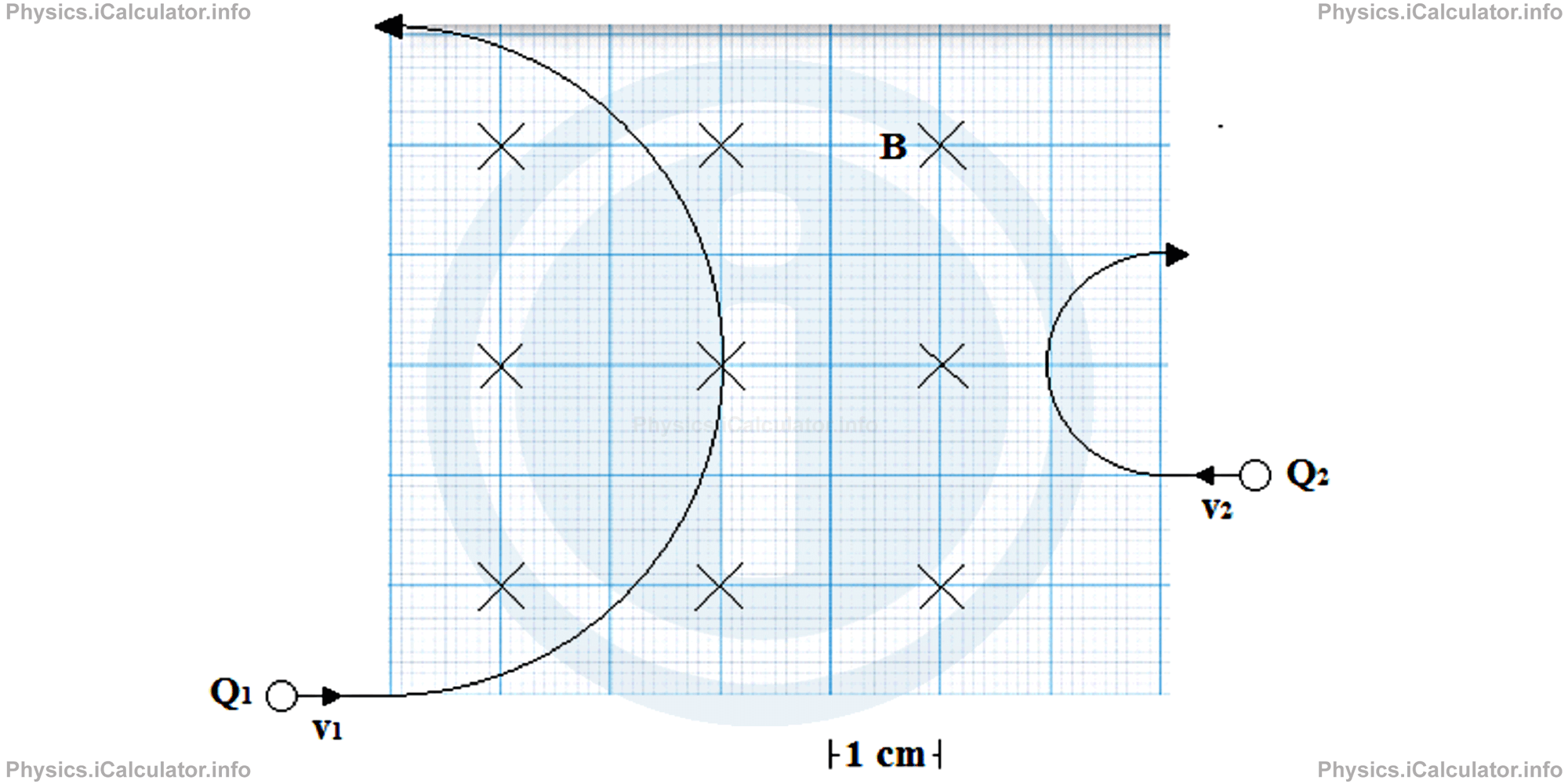Menu
Physics Lesson 16.4.2 - Moving Trajectory of a Particle inside a Magnetic Field
Please provide a rating, it takes seconds and helps us to keep this resource free for all to use
Welcome to our Physics lesson on Moving Trajectory of a Particle inside a Magnetic Field, this is the second lesson of our suite of physics lessons covering the topic of Magnetic Force on a Wire Moving Inside a Magnetic Field. Lorentz Force, you can find links to the other lessons within this tutorial and access additional physics learning resources below this lesson.
Moving Trajectory of a Particle inside a Magnetic Field
In the previous paragraph, we explained that magnetic force is always perpendicular to the moving direction of charges. (Do not confuse the moving direction of charges - which is usually determined by the shape of conducting wire - with the direction of wire's motion - which occurs in the direction of magnetic force. They are completely different things.)
Given this, it is clear that the magnitude of velocity (that is the speed) of moving charges placed inside a magnetic field is constant, as in this case, the velocity has no component in the direction of magnetic force. This means the kinetic energy of charged particles inside a magnetic field is constant as well (KE = mv2/2). From the law of Work-Kinetic Energy conversion, we known that when the kinetic energy is constant, no work is done by the magnetic force on moving charges (W = ΔKE = KEf - KEi = 0).
Such a situation (the displacement of charges be zero when charges are in motion) can occur only if the motion is periodic, i.e. when it repeats itself in equal time intervals. The most common periodic type of motion is the uniform circular motion. Therefore, any particle placed inside a uniform magnetic field will move in uniform circular motion, where the magnetic force will act as a centripetal force, as shown in the figure below.

The radius of the curved path is obtained through the magnetic-centripetal force equivalence. Thus, we have
Q ∙ v ∙ B = m ∙ v2/r
Q ∙ B = m ∙ v/r
Therefore, we obtain for the radius of circular path followed by a charged particle in a magnetic field:
where m is the mass of the charged particle. Thus, if the magnetic field is uniform (B is constant), the radius r of the particle's circular path does not change as all the other quantities in the above formula are constant as well.
Given that the period of a uniform circular motion is calculated by dividing circumference by speed, we obtain for the period of rotation for a particle in circular motion inside a uniform magnetic field:
= 2π ∙ m ∙ v/Q ∙ B/v
= 2π ∙ m/Q ∙ B
As you can see, the period of rotation is independent from the moving speed of the particle.
Example 3
Two electric charges of equal magnitudes (4 μC each) enter inside a 40 mT uniform magnetic field as shown in the figure.

Calculate:
- The type of charge Q1 and Q2 the corresponding objects contain
- The masses of the two charges
- The speeds by which charges move inside the field
- The period of rotation for each charge
- The ratio between magnetic forces F1 / F2 produced
Take mproton = 1.67 × 1027 kg, melectron = 9.1 × 10-31 kg, e = 1.6 × 10-19 C.
Solution 3
- Using the Fleming's Left Hand Rule, we find out that the charge Q1 is positive and Q2 is negative. Another way to prove this is to see the turning direction of charges. Thus, when a positive charge enters inside an onto-the-page magnetic field, the magnetic force is equal to the corresponding centripetal force, producing an anticlockwise turning effect as explained earlier, while when the charge is negative, it rotates in the opposite direction (clockwise).
- Since all values of electric charges - whether positive or negative - are multiples of elementary charge, first we find the number n of protons or electrons contained in each charge and then, we multiply them by the mass of the corresponding elementary charges e. We have Q = n ∙ e ⟹ n = Q/eSince Q1 = + 4μC and Q2 = -4μC, we obtain for the masses m1 and m2 of the charged objects:
= 4 × 10-6 C/1.6 × 10-19
= 2.5 × 1013 chargesm1 = n ∙ mpand
= 2.5 × 1013 ∙ 1.67 × 10-27 kg
= 4.175 × 10-14 kgm2 = n ∙ me
= 2.5 × 1013 ∙ 9.1 × 10-31 kg
= 2.275 × 10-17 kg - The speeds of each charged object are calculated using the equation r = m ∙ v/Q ∙ BFrom the figure we can see that r1 = 3 cm = 3 × 10-2 m (3 units in the figure), and r2 = 1 cm = 10-2 m (1 unit in the figure). Therefore, for the positive charge Q1 we havev1 = r1 ∙ Q1 ∙ B/m1and for the negative charge Q2, we have
= (3 × 10-2 m) ∙ (4 × 10-6 C) ∙ (4 × 10-2 T)/4.175 × 10-14 kg
= 11.497 × 104 m/s
= 114 970 m/sv2 = r2 ∙ Q2 ∙ B/m2
= (1 × 10-2 m) ∙ (4 × 10-6 C) ∙ (4 × 10-2 T)/2.275 × 10-17 kg
= 7.033 × 107 m/s
= 70 330 000 m/s - The period of rotation for the first charge is T1 = 2π ∙ m1/Q1 ∙ Band that of the second charge is
= (2 ∙ 3.14) ∙ (4.175 × 10-14 kg)/(4 × 10-6 C) ∙ (4 × 10-2 T)
= 1.64 × 10-6 sT2 = 2π ∙ m2/Q2 ∙ B
= (2 ∙ 3.14) ∙ (2.275 × 10^(-17) kg)/(4 × 10-6 C) ∙ (4 × 10-2 T)
= 8.93 × 10-10 s - We can calculate the magnetic forces acting on each charge in two ways:
- Using the formula F = Q ∙ v ∙ B for each charge, or
- Using the formula of centripetal force F = m ∙ v2 / r for each charge.
F1 = m1 ∙ v12/r1and for the second charge, we have
= (4.175 × 10-14 kg) ∙ (11.497 × 104 m/s)2/(3 × 10-2 m)
= 1.84 × 10-2 NF2 = m2 ∙ v22/r2These results are confirmed by means of the first method. Thus, for the first magnetic force, we have
= (2.275 × 10^(-17) kg) ∙ (7.033 × 107 m/s)2/1 × 10-2 m
= 112.5 × 10-1 N
= 11.25 NF1 = Q1 ∙ v1 ∙ B = (4 × 10-6 C) ∙ (11.497 × 104 m/s) ∙ (4 × 10-2 T)and for the second magnetic force, we have
= 184 × 10-4 N
= 1.84 × 10-2 NF2 = Q2 ∙ v2 ∙ BAs you see, the results are the same in both methods.
= (4 × 10-6 C) ∙ (7.033 × 107 m/s) ∙ (4 × 10-2 T)
= 112.5 × 10-1 N
= 11.25 N
You have reached the end of Physics lesson 16.4.2 Moving Trajectory of a Particle inside a Magnetic Field. There are 3 lessons in this physics tutorial covering Magnetic Force on a Wire Moving Inside a Magnetic Field. Lorentz Force, you can access all the lessons from this tutorial below.
More Magnetic Force on a Wire Moving Inside a Magnetic Field. Lorentz Force Lessons and Learning Resources
Whats next?
Enjoy the "Moving Trajectory of a Particle inside a Magnetic Field" physics lesson? People who liked the "Magnetic Force on a Wire Moving Inside a Magnetic Field. Lorentz Force lesson found the following resources useful:
- Trajectory Feedback. Helps other - Leave a rating for this trajectory (see below)
- Magnetism Physics tutorial: Magnetic Force on a Wire Moving Inside a Magnetic Field. Lorentz Force. Read the Magnetic Force on a Wire Moving Inside a Magnetic Field. Lorentz Force physics tutorial and build your physics knowledge of Magnetism
- Magnetism Revision Notes: Magnetic Force on a Wire Moving Inside a Magnetic Field. Lorentz Force. Print the notes so you can revise the key points covered in the physics tutorial for Magnetic Force on a Wire Moving Inside a Magnetic Field. Lorentz Force
- Magnetism Practice Questions: Magnetic Force on a Wire Moving Inside a Magnetic Field. Lorentz Force. Test and improve your knowledge of Magnetic Force on a Wire Moving Inside a Magnetic Field. Lorentz Force with example questins and answers
- Check your calculations for Magnetism questions with our excellent Magnetism calculators which contain full equations and calculations clearly displayed line by line. See the Magnetism Calculators by iCalculator™ below.
- Continuing learning magnetism - read our next physics tutorial: Magnetic Dipole Moment
Help others Learning Physics just like you
Please provide a rating, it takes seconds and helps us to keep this resource free for all to use
We hope you found this Physics lesson "Magnetic Force on a Wire Moving Inside a Magnetic Field. Lorentz Force" useful. If you did it would be great if you could spare the time to rate this physics lesson (simply click on the number of stars that match your assessment of this physics learning aide) and/or share on social media, this helps us identify popular tutorials and calculators and expand our free learning resources to support our users around the world have free access to expand their knowledge of physics and other disciplines.
Magnetism Calculators by iCalculator™
- Angular Frequency Of Oscillations In Rlc Circuit Calculator
- Calculating Magnetic Field Using The Amperes Law
- Capacitive Reactance Calculator
- Current In A Rl Circuit Calculator
- Displacement Current Calculator
- Electric Charge Stored In The Capacitor Of A Rlc Circuit In Damped Oscillations Calculator
- Electric Power In A Ac Circuit Calculator
- Energy Decay As A Function Of Time In Damped Oscillations Calculator
- Energy Density Of Magnetic Field Calculator
- Energy In A Lc Circuit Calculator
- Faradays Law Calculator
- Frequency Of Oscillations In A Lc Circuit Calculator
- Impedance Calculator
- Induced Emf As A Motional Emf Calculator
- Inductive Reactance Calculator
- Lorentz Force Calculator
- Magnetic Dipole Moment Calculator
- Magnetic Field At Centre Of A Current Carrying Loop Calculator
- Magnetic Field In Terms Of Electric Field Change Calculator
- Magnetic Field Inside A Long Stretched Current Carrying Wire Calculator
- Magnetic Field Inside A Solenoid Calculator
- Magnetic Field Inside A Toroid Calculator
- Magnetic Field Produced Around A Long Current Carrying Wire
- Magnetic Flux Calculator
- Magnetic Force Acting On A Moving Charge Inside A Uniform Magnetic Field Calculator
- Magnetic Force Between Two Parallel Current Carrying Wires Calculator
- Magnetic Potential Energy Stored In An Inductor Calculator
- Output Current In A Transformer Calculator
- Phase Constant In A Rlc Circuit Calculator
- Power Factor In A Rlc Circuit Calculator
- Power Induced On A Metal Bar Moving Inside A Magnetic Field Due To An Applied Force Calculator
- Radius Of Trajectory And Period Of A Charge Moving Inside A Uniform Magnetic Field Calculator
- Self Induced Emf Calculator
- Self Inductance Calculator
- Torque Produced By A Rectangular Coil Inside A Uniform Magnetic Field Calculator
- Work Done On A Magnetic Dipole Calculator